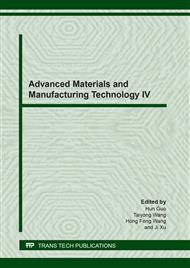p.3
p.12
p.22
p.32
p.42
p.54
p.63
p.72
Simulation Analysis of Aviation Aluminum Alloy Reaming Processes by Using PCD Reamer
Abstract:
Cutting force and cutting temperature are two important parameters in the cutting processes. In this paper, AdvantEdge finite element analysis software was used to simulate and analyze the reaming process of aviation aluminum alloy 7050 by using PCD reamer. The cutting simulation model was established to investigate the effect of spindle speed, feed per tooth on thrust force and cutting temperature. Simulation results showed that the cutting force increased with the increase of feed per tooth at different spindle speeds. And in the case of different feed per tooth, the cutting force decreased slightly as the spindle speed increase. Besides, from the cutting temperature distributed in the reamer, the cutting temperature near the tip of the tool in the reaming process was highest, the cutting temperature increased with the increase of both spindle speed and feed per tooth.
Info:
Periodical:
Pages:
3-11
Citation:
Online since:
October 2020
Authors:
Keywords:
Price:
Сopyright:
© 2020 Trans Tech Publications Ltd. All Rights Reserved
Share:
Citation:


